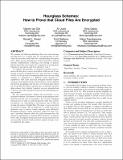| dc.contributor.author | van Dijk, Marten | |
| dc.contributor.author | Juels, Ari | |
| dc.contributor.author | Oprea, Alina | |
| dc.contributor.author | Rivest, Ronald L. | |
| dc.contributor.author | Stefanov, Emil | |
| dc.contributor.author | Triandopoulos, Nikos | |
| dc.date.accessioned | 2014-10-08T14:37:02Z | |
| dc.date.available | 2014-10-08T14:37:02Z | |
| dc.date.issued | 2012-10 | |
| dc.identifier.isbn | 9781450316514 | |
| dc.identifier.uri | http://hdl.handle.net/1721.1/90626 | |
| dc.description.abstract | We consider the following challenge: How can a cloud storage provider prove to a tenant that it's encrypting files at rest, when the provider itself holds the corresponding encryption keys? Such proofs demonstrate sound encryption policies and file confidentiality. (Cheating, cost-cutting, or misconfigured providers may bypass the computation/management burdens of encryption and store plaintext only.)
To address this problem, we propose hourglass schemes, protocols that prove correct encryption of files at rest by imposing a resource requirement (e.g., time, storage or computation) on the process of translating files from one encoding domain (i.e., plaintext) to a different, target domain (i.e., ciphertext). Our more practical hourglass schemes exploit common cloud infrastructure characteristics, such as limited file-system parallelism and the use of rotational hard drives for at-rest files. For files of modest size, we describe an hourglass scheme that exploits trapdoor one-way permutations to prove correct file encryption whatever the underlying storage medium.
We also experimentally validate the practicality of our proposed schemes, the fastest of which incurs minimal overhead beyond the cost of encryption. As we show, hourglass schemes can be used to verify properties other than correct encryption, e.g., embedding of "provenance tags" in files for tracing the source of leaked files. Of course, even if a provider is correctly storing a file as ciphertext, it could also store a plaintext copy to service tenant requests more efficiently. Hourglass schemes cannot guarantee ciphertext-only storage, a problem inherent when the cloud manages keys. By means of experiments in Amazon EC2, however, we demonstrate that hourglass schemes provide strong incentives for economically rational cloud providers against storage of extra plaintext file copies. | en_US |
| dc.language.iso | en_US | |
| dc.publisher | Association for Computing Machinery (ACM) | en_US |
| dc.relation.isversionof | http://dx.doi.org/10.1145/2382196.2382227 | en_US |
| dc.rights | Creative Commons Attribution-Noncommercial-Share Alike | en_US |
| dc.rights.uri | http://creativecommons.org/licenses/by-nc-sa/4.0/ | en_US |
| dc.source | Other repository | en_US |
| dc.title | Hourglass schemes: how to prove that cloud files are encrypted | en_US |
| dc.type | Article | en_US |
| dc.identifier.citation | Marten van Dijk, Ari Juels, Alina Oprea, Ronald L. Rivest, Emil Stefanov, and Nikos Triandopoulos. 2012. Hourglass schemes: how to prove that cloud files are encrypted. In Proceedings of the 2012 ACM conference on Computer and communications security (CCS '12). ACM, New York, NY, USA, 265-280. | en_US |
| dc.contributor.department | Massachusetts Institute of Technology. Department of Electrical Engineering and Computer Science | en_US |
| dc.contributor.mitauthor | Rivest, Ronald L. | en_US |
| dc.relation.journal | Proceedings of the 2012 ACM conference on Computer and communications security (CCS '12) | en_US |
| dc.eprint.version | Author's final manuscript | en_US |
| dc.type.uri | http://purl.org/eprint/type/ConferencePaper | en_US |
| eprint.status | http://purl.org/eprint/status/NonPeerReviewed | en_US |
| dspace.orderedauthors | van Dijk, Marten; Juels, Ari; Oprea, Alina; Rivest, Ronald L.; Stefanov, Emil; Triandopoulos, Nikos | en_US |
| dc.identifier.orcid | https://orcid.org/0000-0002-7105-3690 | |
| mit.license | OPEN_ACCESS_POLICY | en_US |
| mit.metadata.status | Complete | |
